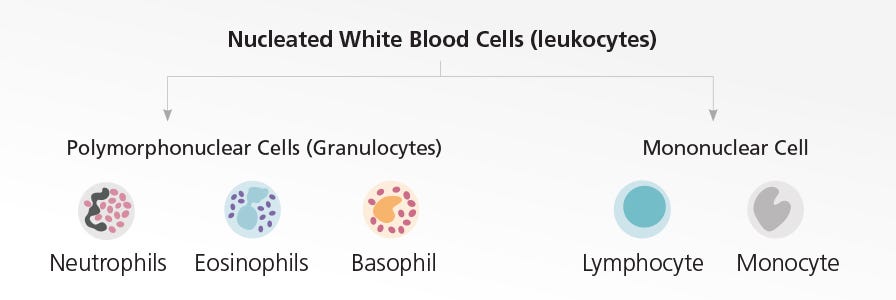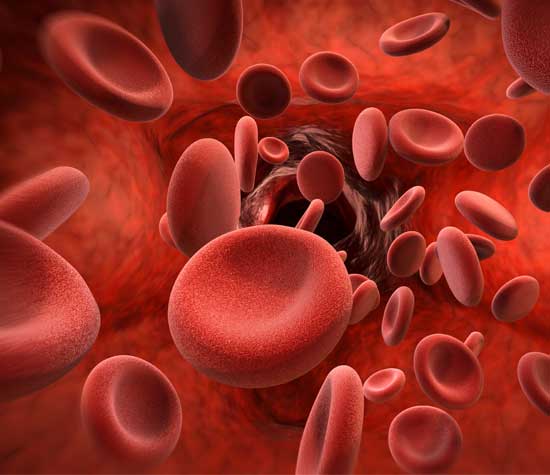Process of blood circulation
Glucose and oxygen are the main components to produce energy in the body. Blood is the transport medium of both the above components to the cells and the waste out of the cells.
Blood is a special connective tissue. It is a red colour fluid. When blood is centrifuged and kept aside, there will be two different layers. The dark red layer consists of blood corpuscles while the pale yellow layer contains the plasma. On this basis, blood which is seen as a homogeneous fluid, contains a plasma and a suspension of corpuscles. When a slide with a blood smear observed through the microscope there will be several types of corpuscles in it.
Red Blood cells (Erythrocytes)
One cubic millimetre of human blood contain
about five million of red blood cells. These red
coloured and biconcave disc-like cells are clearly
visible among the other corpuscles. They form in
red bone marrow. The life span of RBC is about
four months (120 days). Absence of nucleus in
red blood cells provides a large surface area to
absorb more oxygen. A pigment called
haemoglobin is present in red blood cells.
Haemoglobin binds with oxygen and form
oxyhaemoglobin to transport oxygen to cells.
White Blood cells
A type of corpuscle, larger than the size of red blood cells, but smaller in number is
present in blood. They are with nuclei and form in bone marrow. They are colourless
and known as white blood cells. The ratio between red blood cells to white blood
cells is 600:1
Two Types of WBC present in blood
- Granulocytes
- Non-granulocytes
Granulocytes are further divided into three types
- Neutrophils
- Eosinophils
- Basophils
Non-granulocytes are in two types
One cubic millimeter (1 mm3
) of human blood contains 4 000 - 11 000 number of
WBC.

WBC destroy infectious particles that enter the body by phagocytosis. Therefore
percentages of WBC increase above the normal levels in microbial infections.
Investigation of WBC counts in blood helps to diagnose diseases.
The function of WBC is to protect the body from infectious particles that enter the
body. This is done by phagocytosis and by producing antibodies.
Platelets
In addition to RBC and WBC there are fragments of cells that cannot be considered
as cells in human blood. These corpuscles without nuclei are known as platelets.
One cubic milimetre of blood contains 150 000-400 000 platelets. They form in
bone marrow. Life span of platelets is approximately 5-7 days. Due to diseases
like Dengue and Leptospirosis, platelet count drops drastically. Platelets contain
thromboplastin which help in coagulation of blood.
Blood plasma
92% of blood plasma is water. Other than water the second most abundant compound
is protein. Nutrients, nitrogenous waste, hormones, enzymes, gases and ions are
present in blood plasma.
Transportation of materials (digested end products, respiratory gases, excretory
byproducts, hormones, mineral ions and proteins)
Protect body against pathogenic microbes by phagocytosis and by producing
antibodies.
Maintenance of chemical coordination and homeostatis among tissues and
organs
Blood Circulation
Arterial system
consists of all the
arteries in the blood
circulatory system. It
transports oxygenated
blood. But pulmonary
artery transports
deoxygenated blood
to the lungs. Venous
system consists of all
the veins in the blood
circulatory system. It transports
deoxygenated blood.
But pulmonary veins transport oxygenated blood from lungs to the left atrium.
Blood circulation of human
Double blood circulation
The circulation where
blood flows through lungs
is known as pulmonary
circulation. The
circulation where blood
flows through the rest of
other organs is known as
systemic circulation.
Right ventricle of the heart
acts as the pump for the
pulmonary circulation, and
left ventricle for the
systemic circulation. So it
is clear that blood flows twice through heart before entering into systemic artery. In
human, when the blood circulates once through the body it flows twice through the
heart. This is called as double circulation.
Heart beat
Atria and Ventricles of heart contract to pump blood out of the heart. These
contractions and dilations of heart muscle are known as heart beat. The heart beat
rate of a healthy person at rest, is 72 beats per minute. Pulse rate is also similar to
heart beat rate.
Cardiac cycle
In one heart beat atria contract when ventricles dilate. Next ventricles contract, atria
dilate. Contraction of atria is known as diastole (0.1 seconds) whereas contraction
of ventricles is known as systole (0.3 seconds). After that atria and ventricles are in
relax mode and it is known as intervening (0.4 seconds).
Cardiac cycle refers to a complete heart beat from its generation to the beginning of
the next beat. The stages of cardiac cycle are as follows
- Diastole - Atrial contraction
- Systole - Ventricular contraction
- Intervening - Atrial and Ventricular relaxation (complete cardiac diastole)








No comments:
Post a Comment